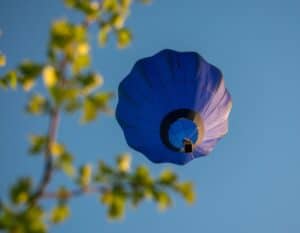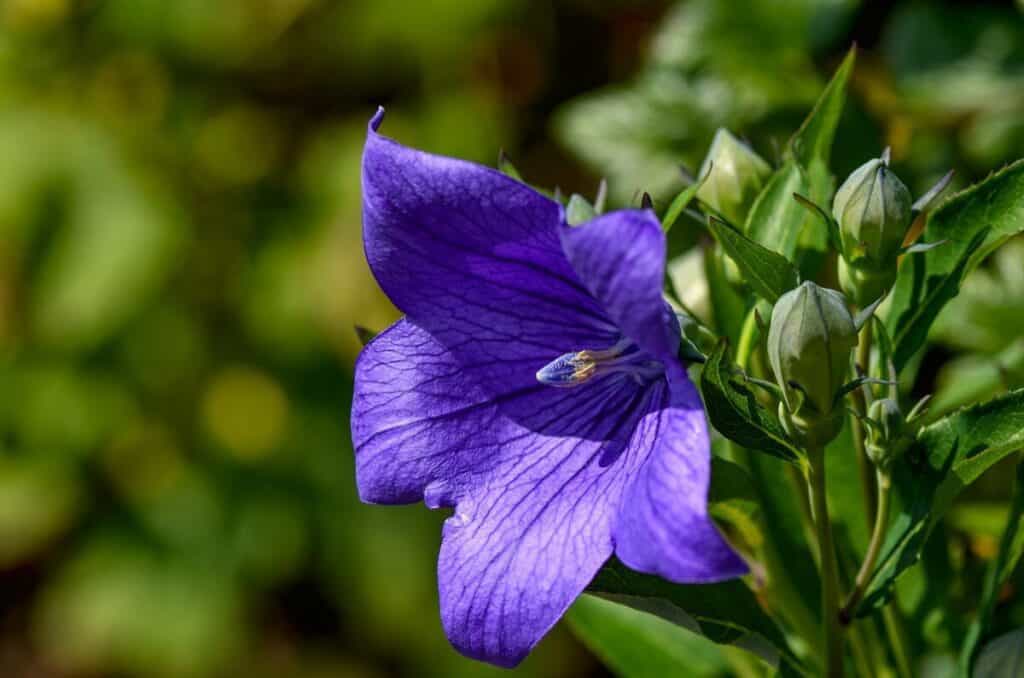A Perennial To Plant In Spring and Fall!
The whimsical blue balloon flower is a vigorous, compact herbaceous perennial. It is a long-living, flowering plant that rarely needs division and while humans love their quirky, playful buds, deer, happily do not.
Balloon Flower- Platycodon grandiflorus
Balloon Flower-Platycodon grandiflorus Platycodon is a genus of perennial herbs with bell-shaped blue flowers and Grandiflorus implies large flowers. The small plant will produce an abundance of long-lasting, vivid blue flowers the plant makes a perfect edging for a bed or enhance a mixed floral border.
The bud looks like a small gift package as it comes out and steadily turns into what appears to be a miniature hot air balloon. See it in the featured image at the start of this article.
The balloon flower, usually blue, you may have guessed, is a member of the Campanulaceae family which makes it a relative of the many varieties of bellflower.
Like The Montglofier Brothers’ Balloon
I have heard these buds described as looking like the balloon that carried two 18th-century French science teachers about 3000 feet over Paris in 1783. That’s sort of the “Around the world in 80 days look” which seems appropriate when you see the flower.

How Did We Get The Whimsical Blue Balloon Flower Plant?
The flower is native to China, Japan, Korea, and northern Russia. We understand it to be brought west by the Scottish Plant hunter, Robert Fortune who is credited with supplying the western world with 250 new plants. I think of him whenever I pick a Kumquart from my patio tree in Florida.
He was a colorful character who circumvented China’s ban on Western traders by passing himself off as an important Chinese trader. I am not sure how that was done but that is the story!
| HEADINGS | INFORMATION |
| Plant Name, Common | Bee Balm |
| Plant Name, Botanical | Monarda didyma |
| Significant Attributes | Colorful spikes of densely packed tubular flowers |
| Color | Blue, purple, red, pink, white, yellow. |
| Scent | aromatic |
| Bloom Period | Midsummer on. In warm zones all year. |
| Hardiness Zones | 4-10 |
| Light Requirements | Full sun. |
| Soil Requirements | Well-drained, with compost, light, fertile, loamy, moist but with drainage. Never wet. |
| Soil pH | Neutral to slightly alkaline |
| Water Requirements | Water in AM. Regular water in summer, do not allow plants to stand in soggy soil in winter |
| Plant Type | Perennial, and annual versions. For zone 10 annuals last several years. |
| Garden Usage | Beds. borders, containers, cottage garden, cut flowers. |
| Size | 18:-5′. Check varieties |
| Planting Distance | 18-24″ apart. |
| Pollinators and Wildlife | Yes |
| Cautions | very few pests and diseases. |
Balloon Flower Varieties-Always Whimsical-Not Quite Always Blue
Apoyama
Aoyama, is an erect, clump-forming perennial. The roots are used as a vegetable and if you are ambitious it gives you ingredients for Sake!
Apoyama Misato Purple
This is a dwarf form of the plant with a deep purple color and rich venation. It blooms later in spring than some other varieties but compensates by being easy to grow and with a rich, long bloom period.
Astra Blue Balloon Flower
Astra Blue is a double-blue blossomed hybrid plant with a true periwinkle blue color. It is long-lived and considered trouble-free. Its compact shape makes it desirable for the front of the border.
Double Blue
This variety has a height, reaching 24-30″. It is a true double flower of 10 petals.
Fairy Snow
A white flowering, dwarf variety, its flowers are 1.5 inches across.l The plant will grow 6-10″ in height.
Hakone Double Blue
This is a crossbreeding that produces 10 petaled double blue flowers.
Hakone Double White
This one gives us two colors, pure white flowers, and blue buds. The flowers are double and the plant can stand hot summers but not a frost.
Kiomachi
This is the flower for you if you just love the balloon. It never opens, what you get are big balloons.
Mother Of Pearl
This is a taller version, to 24″ and a rare variety. It has large pale pink flowers with darker venation.
Sentimental Blue
The flowers of sentimental blue are vibrant blue and appear throughout the summer on stems of 6-12″.
How To Grow Balloon Flower
How To Plant Balloon Flower Roots

Here is the flower fully opened and in the bud.
Small balloon flower plants are available from growers in the fall, you will find them in pots and as bare-root plants. Remember, that the flower appears slowly in spring, following many other plants, its first shoots look a lot like asparagus. Because of the slowness of emergence, it is a good idea to mark their planting location so that you do not destroy them in your early spring weeding
You can add the whimsical balloon flower to the garden in spring and fall. Here is a list of perennials to plant in the fall that you may not have thought of so far.
Stake The Balloon Flower Plants
As the young plants begin to grow it is a good idea to stake them. This is particularly true of the taller varieties.
Planting From Seed
You can plant them in spring from seeds, although they may not flower in the first season. They should require stratification in order to germinate. Stratification is a procedure that simulates the chilling and warming that the seeds go through over a winter. You can put them in dampened sand, peat, or even paper towels in the refrigerator in a sealed container. This should take four or five weeks. Requiring cold is nature’s way to prevent the seeds from starting in winter thaws.
Plant the seeds after all danger of frost has passed. The seeds require the sun to germinate, plant them over a layer of compost dug into the soil and water. You should see sprouts in about two weeks. Here is a good article about sowing the seeds.
Moving The New Plants
After a few weeks, you should be able to pot these plants and put them where you want them. The balloon flower is a plant with a taproot and should not be considered portable.
This is a job for the truly dedicated gardener, it is an activity my mother’s generation would have done and is one reason why garden centers exist.
Soil For Balloon Flowers
Well-drained and moist soil with organic matter is ideal. They grow in almost any pH, but slightly acidic soil is most desirable.
Water and Fertilizer
Steadily moist, but not wet soil is ideal, when established they have reasonable drought tolerance and do not require fertilizer other than compost added in fall.
Maintenance and Winterization
Do Balloon Flowers Need To Be Deadheaded?
Deadheading individual flowers as they die will produce a considerable improvement in flower quantity. If you leave the brown tips late in the season they will produce seeds.
How To Deadhead Balloon Flowers
Deadhead regularly for maximum blooms. Do this by removing the flower, and cutting back to the very next leaf joint. Do not remove all the stems. To winterize, keep deadheading, clean any dead plant material from around the base of the plants, and apply a layer of mulch but do not trim or apply fertilizer. It is time for dormancy, and water until the ground freezes.
Pests And Diseases
Bogrytis Gray Mold
In cool, damp conditions this produces mottled and blotched leaves. Trim off any dead material.
Rust Diseases
Look for yellow areas on leaves and powdery spots on the underside of leaves. Remove infected material as soon as seen. Space plants to ensure good ventilation.
Powdery Mildew
This will present as a white or gray powdery covering on leaves. The best environment for this disease is an extremely dry or humid environment.
Gardening Is Both Universal and Local-Balloon Flower-A Good Example
It is obvious to us all that gardening is universal, that happened when we gave up the hunter-gatherer existence. The fact that we all garden is one of its great charms.
But we cannot ever forget that gardening is local. What works in my zone 10 gardens didn’t work in my zone 3 or 7 gardens. The issue of invasiveness is an important example.
My Monstera Deliciosa Alba Variegata
A beautiful plant with enormous leaves of brilliant green and white, it has been called the most expensive plant in the world. With its tropical origins, I could plant it in the soil. But I do not! In Florida, it is wildly invasive doing considerable damage to wetlands.
I grow it in a pot, just as you in a northern climate would do. Native to Central America it is a good citizen in plenty of environments-just, not mine!
The balloon flower has a similar story, a well-credentialed gardener in the Mid-Atlantic region finds it invasive. Cornell University, in a colder climate, does not.
What to do? Check locally. Your county extension service, your best local garden center, your Master Gardener clinics, or your nearest botanical garden will help.
Why So Expensive? Ways To Buy One?
We think that as the large white expanse produces little chlorophyll, thus the plant photosynthesizes slowly. It is also a high-status house plant.
How did I get one at a reasonable price? We volunteer Master Gardeners operate an annual Garden Show and Sale. We have many local vendors and growers who produce beautiful plants for us at reasonable prices. Get to know your local Master Gardeners, you’ll be glad you did!
Note on Invasiveness
I found this article on a website maintained by a gardener in the Washington DC area who finds the plant invasive. Balloon flower has a deep and vigorous taproot and the seeds produce easily. Here is the article.
Here is the link to the balloon flower on the Cornell University site. It pays to check before you plant.
Summary,
The balloon flower is a whimsical addition to the garden attracting adults and children into the garden. One of its greatest dangers is people’s desire to pop the buds before they bloom! The plants are also attractive to pollinators and birds.
Where To Buy Balloon Flower Plants
You should find both seeds and new plants in the spring and fall at your local garden center if you garden in hardiness zones 3-8.
Companion Plantings
What To Plant With Balloon Flowers
Try the pink and white versions with ornamental grasses for contrast.
Combine the plentiful blue varieties with yellow lilies, yarrow, and daylilies. Also use echinacea, yarrow, or coreopsis.
